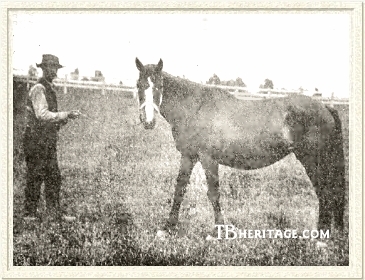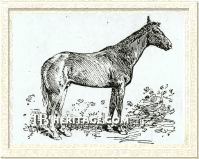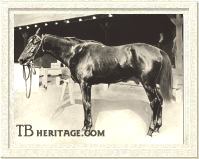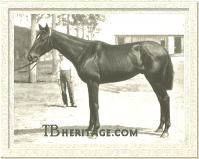|
|
Cinderella

|
|
 |
|
|
In the obituary of Cinderella which appeared in The Thoroughbred Record in the spring of 1906, Cinderella was compared to England's famed producer Pocahontas. That celebrated matron produced three sons who each became important stallions, their offspring proving highly influential to the breed. Cinderella deserved this comparison, as during her long stud career, she produced two sons whose male lines have survived to the present day.
Cinderella was bred in England by Sir Thomas Throckmorton. She was sold as a yearling when Alfred Withers, acting on behalf of Sir Thomas, contacted an American in Kentucky, Egmont Lawrence, about shipping a consignment of horses to Kentucky and selling them there. All told, ten horses were shipped to Lexington, two of which were yearlings, Cinderella and Tarantella. Dr. Neet purchased the two fillies after their arrival in Kentucky, paying $500 for Cinderella and $400 for Tarantella.
Cinderella was a small, weedy bay specimen with an irregular blaze slashing down her face. On her sire's side, her pedigree was suspect, as she was said to be by Blue Ruin or Tomahawk, "with Tomahawk preferred." Her dam was Manna, by Brown Bread, a winner of the Northumberland Plate. Of the two sires given, Tomahawk was the more intriguing. He was a winner of the Lincolnshire Handicap, and boasted a fine pedigree, as he was by King Tom out of the One Thousand Guineas winner Mincemeat (by Sweetmeat), making him a full brother to One Thousand Guineas winner Tomato. The female line of Cinderella had been somewhat quiescent for several years prior to her birth, yet it was a family which had produced more than its fair share of top class performers. Cinderella traced to the Orville mare, and from that mare descended Oaks winner Iris; St. Leger and Doncaster Cup winner Charles XII; Doncaster Cup winner Laurel; and the aforementioned Sweetmeat, an unbeaten winner of sixteen races at age three, whose career stakes victories included the Doncaster Cup and the Ascot Gold Vase. If Tomahawk was indeed the sire of Cinderella, it made her inbred 3x3 to the half-siblings Sweetmeat and the Don John mare.
Cinderella's unattractiveness was more than physical, for her personality left much to be desired. She was nothing like her literary namesake, instead her temperament being more akin to Cinderella's evil sisters. Cinderella was bad-tempered and vicious, a trait she went on to transmit on to some of her offspring. It was probably no coincidence that two of her sons were gelded.
Cinderella was broken by John Clay at the training stable of Major Barak G. Thomas. Her early workouts proved she had good speed, but she never raced. Dr. Neet decided Cinderella's destiny lay in becoming a broodmare and bred her when she was three. Her first foal, a chestnut colt by 1880 Kentucky Derby winner Fonso, was born in 1889 and named FOREIGNER. He was a good two-year-old, capturing the Turf, Field, and Farm Stakes and four other races at two. |

Ferrier
|
|
Her next, born in 1890, was a chestnut colt by Travers Stakes winner Falsetto which was given the name FERRIER. This colt was blessed with an iron constitution. He raced from the age of two through nine, starting 148 times, for 55 victories, winning from New York to California. During a two year period, Ferrier won seventeen consecutive races. In one race, at Sheepshead Bay, he ran a mile in 1:39 4/5, and in another, at Memphis, he ran seven furlongs in 1:26 1/2, both outstanding times for the day. Ferrier was purchased for stud duty by W.S. Hobart of San Mateo, California. Both Foreigner and Ferrier died young.
|
After slipping her foal by Macduff in 1891, Cinderella in 1892 produced a brown colt by champion Hanover which was named HANDSOME. He was a high class two-year-old, his victories including the Hyde Park Stakes. He was purchased by E.C. Corrigan, the gentleman paying $10,000 for the horse. Eventually, he came back to Dr. Neet's Kindergarten Stud. Unfortunately, Handsome was not a successful stallion.
In 1893 came Cinderella's son by Belmont Stakes winner and champion, Spendthrift. This was the brown colt HASTINGS. Like his dam, Hastings was unassuming in physical appearance, being an ordinary brown with a star on his forehead. His temperament was far from unassuming, however, as he inherited a good deal of his dam's disdainful personality. He became a tremendously successful stallion, heading the American sire list twice, once in 1902 and again in 1908.
Dr. Neet sold Hastings as a yearling at auction, and he went to the partnership of David Gideon and John Daly for $2800. He was sent east to race, winning his first three starts with consummate ease. That summer the Gideon-Daly partnership was dissolved and Hastings was picked up in public auction by August Belmont for $37,000. For Belmont he ran in the Futurity that fall, unplaced. |

Hastings |
|
At three, Hastings defeated older horse sin the Toboggan Handicap and unleashed a thrilling performance in the Belmont Stakes. He lost his last two races of the season, finishing second to stablemate Margrave in the Tidal Stakes and unplaced in the Lawrence Realization. The next year he was out twelve times for four victories and six second place finishes. His major victories included a dead-heat for the win in the Kearney Handicap with Clifford and a victory in the Westchester Highweight Handicap. By the end of the season, his temperament was so bad, it was nearly impossible to train him and he was retired to Belmont's Nursery Stud.
|
Hastings' first crop included Belmont Stakes winner Masterman and Metropolitan Handicap winner Gunfire. The good runners kept coming until the year before his death in 1916. They included Preakness Stakes winner Don Enrique; Metropolitan Handicap winner Glorifier; Kentucky Oaks winner Flamma; and Fair Play. It is through Fair Play that the male line of Cinderella's son Hastings has survived, through Man o' War, War Relic, and descendants Intentionally, In Reality, Relaunch, and Honour and Glory, a current promising young sire representative of this male line.
Cinderella's 1894 foal was a brown colt by Longfellow named CHELSEA. He was not of much account and was gelded. The next year, Cinderella produced another brown colt with a star, this time sired by Himyar, the famed sire of champion Domino. This was PLAUDIT. Dr. Neet sold Plaudit as a yearling. He wound up as a two-year-old in the barn of African-American trainer Ed Brown. Mr. Brown was not a proponent of keeping his young horses in cotton wool. Plaudit started twelve times as a juvenile and won four times. One of these was after his sale to John E. Madden, for whom he won the 1-1/16 mile All Aged race, beating the four-year-old Ben Brush. At the end of the season he had captured the Nursery Stakes and Champagne Stakes and run second in the Dash Stakes in addition to his Cincinnati score and his triumph over Ben Brush.
At three Plaudit won four stakes, including the Kentucky Derby, the Buckeye Stakes, Oakley Stakes, and the Clark Stakes, and ran second in the St. Louis Derby, Latonia Derby, and Lawrence Realization. Along the line, Madden sold Plaudit to William Collins Whitney, but he failed to distinguish himself as a member of that stable, and Madden bought him back to stand stud at his Hamburg Place on the Winchester Road outside Lexington. |

Plaudit |
|
Though not as successful a sire as his half-brother Hastings, Plaudit nevertheless came up with some fine winners, including Spinaway Stakes winner Casuarina; Flash Stakes winner Edward, and champions Plate Glass and King James. His daughter Rosa Mundi produced the Kentucky Oaks winner Rose of Sharon. But it was King James who was the most important of Plaudit's progeny, emerging at age four as champion handicap male. At stud, King James sired Travers Stakes winner Spur, and the line has continued to the present day, with such representatives as Questionnaire, Rough 'n Tumble and his sons Dr. Fager and Minnesota Mac, the latter's son Great Above, and Holy Bull, who is one of today's good stallions, most recently sire of 2005 Kentucky Derby winner Giacomo.
|
In 1896, Cinderella produced her seventh foal, and seventh straight colt. This was a colt by Hanover named GLENHEIM. He was a good two-year-old, winning the Juvenile Stakes. At stud, he accomplished little. Her next foal, DON REAGAN was gelded and was not noteworthy as a racetrack performer. Finally, in 1898, Cinderella produced her first filly. This was GLASS SLIPPER, by Spendthrift. As a full sister to Hastings, Dr. Neet retained Glass Slipper as a broodmare prospect. She produced no stakes winners. Cinderella's next foal was also a filly, EAST INDIA, also retained by Dr. Neet. She did not accomplish anything as a broodmare.
Barren in 1901, Cinderella in 1902 produced another colt, by Top Gallant, named MIGRAINE. This colt did not win any stakes, but he did finish second to Preakness Stakes winner Cairngorm in the Brooklyn Derby, second to champion Sysonby in the Iroquois Stakes, and third to Sysonby and Belmont Stakes winner Tanya in the Lawrence Realization. For a time, he stood at Hamburg Place, but failed to accomplish much as a stallion there. Migraine's most important contribution as a sire was his daughter Dolly Higgins. She became the second dam of Man o' War's champion son Crusader, winner of the Belmont Stakes and two runnings of the Suburban Handicap.
In 1902, when she was seventeen, William Collins Whitney offered Dr. Neet $15,000 for Cinderella. The offer was refused. Whitney persisted, and got Dr. Neet to agree to a lease arrangement for $10,000. Cinderella was moved to Whitney's La Belle Stud near Lexington. In 1903 came a colt named FAIR PRINCE, which presumably died young, as there is no record of him racing or standing at stud. The next year came Cinderella's third filly, sired by Meddler which was named SLIPPERS. Whitney died in January, 1904, which voided the lease agreement. Cinderella was sent back to Dr. Neet, but Whitney's son, Harry Payne Whitney, retained Slippers. She turned out to be the only one of Cinderella's daughters to make a successful broodmare and the only one whose family has bred on.
Bred to champion Hamburg, Slippers produced the colt Buskin. He was gelded, and in 1913, owned and trained by J. Whalen, he captured the Preakness Stakes. When Slippers was bred to Belmont Stakes winner Burgomaster, a son of Hamburg, the result was the filly Polly Flinders. This three-quarter sister to Buskin went on to become one of the jewels in Harry Payne Whitney's breeding program. Though she did not race, Polly Flinders produced high class racetrack performers.
Polly Flinders bred three siblings by Whitney's champion Peter Pan, the fillies Prudery and Prudish, and the colt Macaw. The latter, the youngest of this trio, foaled in 1923, was a durable stakes performer, winning several stakes, including the Queens County and Carter Handicaps. Prudery, foaled in 1918, was a champion runner at both two and three. As a broodmare, Prudery produced classic-winning full brothers by Whisk Broom II, Kentucky Derby winner Whiskery and Preakness Stakes winner Victorian. She was also dam of Halcyon, twice winner of the Queens County Handicap. She did not produce a daughter capable of carrying her branch of Cinderella's family forward. Her sister, Prudish did.
Prudish, one year younger than Prudery, was champion three-year-old filly of 1922. As a broodmare, she produced Comstockery, a winner of the United States Hotel Stakes, and her daughter False Modesty became the dam of stakes winner Haltal. Daughter Mock Modesty, sired by imported Royal Minstrel, founded a branch of the family which has produced a fair amount of good stakes winners, including: Champagne Charlie, Lady Dulcinea, champion filly Heavenly Cause, Quixotic Lady, Petite Rouge, Princess Arjumand, Shy Dawn, and Breeders' Cup Mile winner Opening Verse.
Yet another daughter of Prudish is interesting for another reason. That was Sourdine, a full sister to Mock Modesty. She is ancestress of the first white Thoroughbred ever registered with the American Jockey Club, White Beauty, foaled in 1963. From the female line of White Beauty have descended several white Thoroughbreds, including Precious Beauty and her daughter Patchen Beauty, herself the dam of two white offspring in Spot of Beauty and The White Fox.
Slippers turned out to be Cinderella's final foal. She came up barren in 1905, and in June of 1906, Dr. Neet decided to breed her to Hon. Perry Belmont's Ethelbert. She was sent to Belmont's Horse Haven Stock Farm where she was covered by Ethelbert, but died while still at the farm. The cause was given as heart disease. She was twenty-one years old. It was said Dr. Neet planned to bury her at his farm, though whether this was done remains a mystery. Of her thirteen named foals, ten were colts. Today, there are three male lines extant which can be described as wholly American--those of Domino, Hastings through Fair Play, and Plaudit. Cinderella is responsible for two of them.
--Liz Martiniak
|
|
|
|

